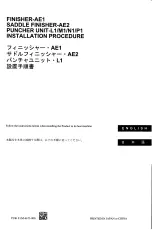
8
Wiring instructions
continued from preceding page
be pulled away when the motorhome turns.
2.
First loosen the set screws on the connector and re-
move the socket from the housing.
Run the wiring through the housing, then strip ¼" to
3/8" of insulation from the ends. Connect the wires accord-
ing to Figure 14.
Tighten all the set screws, and check each wire to
ensure that it is fastened securely. Apply a clear silicone
sealant around each wire entry and set screw indication to
help weatherproof the socket and secure the set screws.
Align the socket keyway to the housing key and insert
the socket back into the housing; tighten the set screws.
3.
Connect the electrical cord to the motorhome and
towed vehicle. Test the towed vehicle's turn signals, tailights
and brake lights to ensure they operate in conjunction with
those of the motorhome.
If the plugs and sockets are not properly wired, the
electrical connection will not function, and the towed
vehicle’s turn signals and brake lights will not mimic
those of the motorhome. Drivers behind the towed
vehicle will not be alerted by turn signals or brake
lights, which may result in a traffic accident, causing
property damage, personal injury or even death.
HOW TO USE SAFETY CABLES
Safety cables are an integral part of your towing system.
They are a secondary safety device, required by law in
many states. This section, and the following section, will
acquaint you with how to use them properly.
•
The safety cables must connect the towing vehicle to
the towed vehicle, frame to frame.
•
The safety cables must be rated at 6,000 pounds weight
capacity per pair, or higher. This is the maximum weight
capacity of the tow bar — the towed vehicle and all its
contents cannot exceed 6,000 pounds.
•
Pull the safety cables so that all the slack is at the mo-
torhome.
Make sure there is enough slack in the cables
at the motorhome to allow for sharp turns
— if there
is not enough slack, the towing system will be severely
damaged when the motorhome turns a sharp corner.
•
The safety cables must be the correct length…
•
Make sure the cables are not too short — if you use a
receiver hitch extension or other equipment that extends
the distance between the towed vehicle and the motor-
home, the standard cables may be too short. If the cables
are too short, the towing system will be severely damaged
when the motorhome turns a sharp corner.
(Safety cable extensions in a variety of lengths are
available from ROADMASTER.)
•
Make sure the cables are not too long — the cables
should not hang down to the extent they may catch on
obstructions, or drag on the ground. This much slack could
cause damage to the towing system, the towed vehicle,
or the motorhome.
If the cables are too long, wrap the excess cable around
the tow bar to take up the slack.
Make sure there is
enough slack in the cables at the motorhome to allow
for sharp turns.
Damage caused by using safety cables of an incorrect
length is not covered under warranty.
•
Always cross the cables under the hitch receiver, as
shown in Figure 16 under “Proper installation of safety
cables.” In the unlikely event the tow bar separates from
the motorhome, crossing the cables will help prevent the
tow bar from dragging on the ground, which can cause
the tow bar to “pole vault” the towed vehicle.
•
Some ROADMASTER tow bar mounting kits with re-
movable arms use two safety cables on each side. If two
sets of safety cables are required, both must be used. This
is required by law. Refer to “Proper installation of safety
cables” for further information.
Failure to follow these instructions may cause prop-
erty damage, personal injury or even death.


































